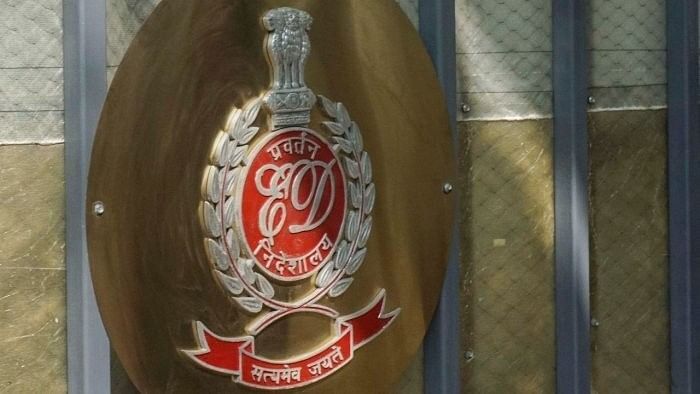
The Enforcement Directorate (ED) logo.
Credit: PTI Photo
The Prevention of Money Laundering Act, 2002 (PMLA) never seems to fade from the news. The bail petitions of several high-profile arrests crop up regularly in various courts, or more recently, a PTI release analysing the ‘intensified’ action by the Enforcement Directorate (ED) in recent years, the agency vested with powers under PMLA, ensures that.
Interpol defines money laundering as concealing or disguising the origins of illegally obtained proceeds to make them appear to have come from legitimate sources. PMLA was enacted in 2002 as part of India’s commitments under international laws, recognising the clear threat money-laundering poses to the financial systems, integrity, and sovereignty of countries. The focus was on preventing the laundering of proceeds from drug crime and drug-related money. Given India’s geographical vulnerability to the flow of drugs, it made eminent sense to have such a law. The law came into force on July 1, 2005.
Substantial amendments were subsequently made to the PMLA in 2009, 2013, and 2019. These amendments were made as per the statement of objects presented to the Parliament at the relevant times to address concerns raised by the Financial Action Task Force (FATF) as well as to plug loopholes or, more specifically, overturn pronouncements by the courts.
It should be noted that these amendments were brought by governments and political parties across the aisle and after due consideration by Standing Committees. (Incidentally, they were all brought about by taking recourse to the Finance Bill/Money Bill route; the challenge of whether PMLA can come within the ambit of a Money Bill is pending for consideration before a larger bench of the Supreme Court.) These amendments changed the character of PMLA significantly, expanded its scope beyond dealing with the proceeds of drug-related crimes, and made it the harsh law it is today.
The law, as it stands after these amendments, defining money laundering has a ‘wider reach’—it captures every process (concealment, possession, acquisition, use, or projecting or claiming as untainted property) and activity in dealing with the proceeds of crime, directly or indirectly, and is not limited to the final act of integration into the formal economy.
Proceeds of crime have been defined to mean any property obtained directly or indirectly, not only derived from the scheduled offence but also any property that may directly or indirectly be derived because of any criminal activity relatable to the scheduled offence.
A long list of offences has been listed in the schedule for the PMLA—the scheduled or predicate offences. They have expanded beyond mere offences under the Narcotics, Drugs, and Psychotropic Substances Act (NDPS) to include laws including the Prevention of Corruption Act, the provisions of which have been invoked in making the high-profile political arrests.
The ED has the power to provisionally attach property derived, directly or indirectly, from any criminal activity relating to a scheduled offence, including assets of equivalent value located even outside the country. The ED officer also has powers of search, seizure, summons, and arrest. This brings us to one of the most discussed provisions of PMLA-Sec 45 relating to bail.
Offences under PMLA are cognizable and non-bailable. Sec. 45 of the Act stipulates that no person accused of an offence under PMLA shall be released on bail unless the Public Prosecutor has been given an opportunity to oppose the application for release and the Court is satisfied that there are reasonable grounds for believing that he is not guilty of such an offence and he is not likely to commit any offence while on bail. All the amendments that substantially expanded the powers of ED under PMLA have been upheld by the Supreme Court in its 2022 decision; the conditions imposed under Sec. 45 have been held to be ‘reasonable’—in other words, bail shall not be considered unless the Court is satisfied that the accused is innocent. It will require a very brave judge to arrive at such a conclusion even before a charge sheet is filed.
PMLA is thus an extraordinary act, having regulatory, preventive, and penal provisions. The decisions of the courts when dealing with petitions relating to bail and attachment of property under PMLA will have to be viewed in this context. It can be argued that PMLA has travelled a long way from its initial purpose of focusing on drug-related proceeds of crime. But this appears to be the legislative intent.
As the analysis by PTI in its release shows, ED has been very busy: 7,264 searches have taken place during 2014–2024; in the same period, 5,155 cases were registered, 755 persons arrested, Rs 1,21,618 crore worth of assets attached, and 1,281 prosecutions launched—a performance that is substantially higher (in some cases by 86 times) compared to the 2005–2014 period. With great power comes great responsibility—the ED will have to act with restraint and ensure that it does not become vulnerable to accusations of misuse of its powers. After all, credibility is of critical importance to all enforcement agencies.
(The writer is a former Chairman of the Central Board of Indirect Taxes & Customs)